-

人教版新目标初中英语八年级下册What were you doing when the UFO arrived教案2篇
(一).知识方面: 1.培养学生能运用过去进行时来描述、谈论过去某个时间正在发生的事情或动作的意识和能力,能就过去某个时间正在发生的动作做出正确的描述。 2.培养学生的想象力和角色扮演的合作能力。 3.培养学生讲述过去发生的事情经过的能力。能正确运用一般过去时来讲述故事。 (二).技能方面: 1.本单元的语言目标是Talk about past events and tell a story(谈论过去的时间和讲述一个故事),围绕这一目标,要涉及句型: What were you doing when the UFO arrived? ----I was sitting in the barber’s chair. The barber was cutting my hair. 因此必须学习standing、studying、cleaning、sleeping、cooking、making、eating、cutting、等表示地点的词,以便为上述句型提供语言材料。2.学习过去进行时的有关知识。Was/were+现在分词,是该时态的表达式。 3.在学习过程中,要区分The boy was walking down the street when the UFO landed.和While the boy was walking down the street, the UFO landed.这两种由when和while引导的状语从句的句型结构。注意它们的不同。

人教版新目标初中英语九年级上册Teenagers should be allowed to choose their own clothes教案2篇
Step 1 Greeting Greet the class and check the homeworkStep 2 A duty report The S on duty gives a report on the rules in his home and lead in 3a “Sun Fei’s and Wu Yu’s rules” Step 3 ReadingSs read the conversation and write the two girls’ rules in the chart. Check the answers.Get Ss to read after the tape and then read aloud by themselves. Then, T explains the language points.Step 4 Pairwork 3bRole play. Use the information in chart to practice with the conversation in 3a covered. They can look at the sample conversation in the right box.Step 5 Task 2 “Who’s the best reporter?”Make a survey by asking any 5 students the questions in the chart in activity 4. Then give out a report about it. See who is the best reporter? And the best reporter will get a nice ball-pen.Step 6 Summary and homework:Write out the report in your exercise-books.Period ThreeStep 1 Greeting and a duty reportThe S gives a duty report talking about his experience of being late for school. Lead in the question “Do you ever get to school late? How often do you get to school late? Always, usually, sometimes, or never?Step 2 1a Get Ss to finish writing.Step 3 Pairwork 1b Get Ss to talk about their answers with their partners using the sample conversation in the box on the right.Step 4 Listening practice2a Lead-in: What will happen if you get to school late? What about Peter? Let’s listen to a conversation between Peter and his father. Get Ss to finish 2a (As usual, for the first time, Ss only listen.) Check the answers.

人教版新目标初中英语九年级上册How do you study for a test教案2篇
内容提示本单元主要内容是学会利用verb十by/with gerund表示方式方法来讨论学习英语的策略,认识自己在学习方面的长处和不足。初步了解现在完成时的结构和用法。现在完成时由助动词have/has+动词的过去分词构成,主要表示过去发生的某一动作对现在仍有影响或造成的后果,常与already,yet,just,ever,never等副词连用。教学目标一、学习目标(Language Goal) 1. Talk about how to study . 学会讨论各种学习方法和策略。2. Find out your suitable learning methods. 找出适合自己的学习方法。 二、语言结构(Language Structures) 1. Verb + by with gerund by+动名词短语 表示“通过…途径,方法” 2. How questions have引导的特殊疑问句 三、目标语言(Target Language) 1. How do you study for tests ? 你是怎样准备考试的?Well , I study by working with my classmates. 哦,我和同学们一起学习。2. Have you ever studied with a group ? 你曾经参加过学习小组吗?Yes , I have . I’ve learned a lot that way . 是的,参加过。通过这种方式我学了许多。

人教版新目标初中英语九年级上册Where would you like to visit教案2篇
The First PeriodⅠ.Teaching Aims and DemandsKnowledge Objects(1) Key Vocabularytiring, educational, fascinating, thrilling, peaceful, exotic, trek, jungle, take it easy, explore, historic, site(2) Target LanguageWhere would you like to go on vacation?I’d like to trek through the jungle, because I like exciting vacations.2. Ability Objects(1)Train students to talk about places they would like to visit with the target language.(2)Train students to describe vacations with different adjectives.(3)Train students' listening skill.3. Moral Object,It′s more interesting to go on vacating somewhere instead of staying at home.Ⅱ. Teaching Key Points1. Key Vocabularytiring, educational, fascinating, thrilling, peaceful, exotic, trek, jungle, take it easy, explore, historic, site2. Target LanguageTalk about different places with the target language.Ⅲ. Teaching Difficult Points1. Describe vacations with different adjectives.2. Talk about different places with the target language.Ⅳ. Teaching Methods1. Teaching by illumination2. Teaching by doing chain drills3. Teaching by pairworkⅤ. Teaching Aids1. A tape recorder2. Some pictures of different places with famous views

人教版新目标初中英语八年级上册I’m more outgoing than my sister教案2篇
1 交通工具的比较此活动为小组活动。学生通过讨论找出到达某一城市可乘坐的各种交通工具,并选择最佳出行方式。Teacher:We’re going to Shanghai. How many ways can we use to get there? Yes, there are four ways: by bus, by plane, by train, by ship. Please discuss how you are going to get there.操作建议:(1)学生以小组为单位展开活动,谈论本组所选择的交通工具。(2)各组选代表向全班汇报,阐述本组所选择的交通工具的利和弊。完成任务所需要的语言结构:We can go there by ship. It’s more comfortable and cheaper than any other transportation.We can go there by bus. It’s cheaper but it takes longer time.2 哪个城市更合适?此活动具有挑战性。假设中国要举行2014年世界杯足球赛,分别从历史,人文,天气等方面对各城市(北京,大连,上海,昆明)进行比较,选择最佳举办城市。T: Imagine China is holding the 2014 FIFA World Cup. Which city do you think is the best for the World Cup, Beijing, Dalian, Shanghai or Kunming? Let’s work in groups. If you choose Beijing, please join the Team Red. If you chose Dalian, please join the Team White. If you choose Shanghai, please join the Team Blue. If you choose Kunming, please join the Team Green. Please show us its advantages. Then let’s see which team will win.

人教版新目标初中英语九年级下册We’re trying to save the manatees教案2篇
本单元主要围绕着有关濒临灭绝的动物这一话题,学习了应该怎样保护我们的环境,以及就某一问题展开辩论。目标提示语言目标能够运用所学知识,就某一问题展开辩论。认知目标1、复习一些语法:现在进行时、一般现在时、用used to 表示一般过去时、现在完成时、一般过去时的被动语态。2、学会表达同意和不同意。3、学会以下基本句型:We’re trying to save the manatees.Manatees eat about 100 pounds of food a day.There used to be a lot of manatees.In 1972,it was discovered that they were endangered.Some of the swamps have become polluted.情感目标了解一些濒临灭绝的动物的生活习性和濒临灭绝的原因,教育学生应该如何保护环境。教学提示充分利用多媒体等教学设备,创设与本课话题相关的情境,如各种不同种类的动物、动物园以及有关环境的画画等等。围绕着本单元的教学目标,设计一些贴近学生实际的教学任务,如让学生谈论自己最喜欢的动物,如何拯救濒危动物,如何保护环境等等。让学生根据所学知识,就动物园是否对动物有利以及其他的话题进行辩论。
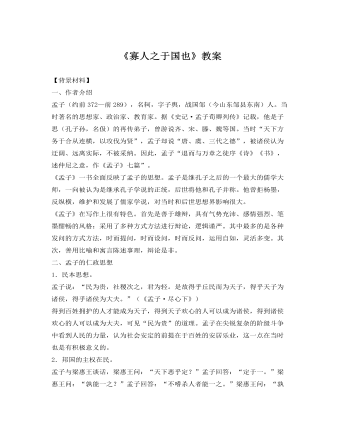
人教版高中语文《寡人之于国也》教案
二、孟子的仁政思想1.民本思想。孟子说:“民为贵,社稷次之,君为轻。是故得乎丘民而为天子,得乎天子为诸侯,得乎诸侯为大夫。”(《孟子·尽心下》)得到百姓拥护的人才能成为天子,得到天子欢心的人可以成为诸侯,得到诸侯欢心的人可以成为大夫,可见“民为贵”的道理。孟子在尖锐复杂的阶级斗争中看到人民的力量,认为社会安定的前提在于百姓的安居乐业,这一点在当时也是有积极意义的。2.邦国的主权在民。孟子与梁惠王谈话,梁惠王问:“天下恶乎定?”孟子回答:“定于一。”梁惠王问:“孰能一之?”孟子回答:“不嗜杀人者能一之。”梁惠王问:“孰能与之?”孟子回答:“天下莫不与也。”(《孟子·梁惠王上》)意思是说,如果一个君王不嗜杀戮,那么,天下没有不愿意把政权交给这个君王的人。万章问孟子:“尧以天下与舜,有诸?”孟子说:“否;天子不能以天下与人。”万章问:“然则舜有天下也,孰与之?”孟子说:“天与之。”
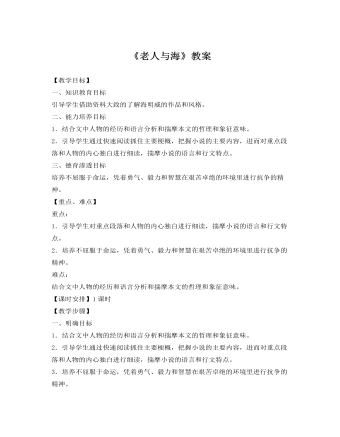
人教版高中语文《老人与海》教案
2.避免使用过多的描写手法,避免过多地使用形容词,特别是华丽的辞藻,尽量采用直截了当的叙述和生动鲜明的对话,因此,句子简短,语汇准确生动。在塑造桑地亚哥这一形象时,他的笔力主要集中在真实而生动地再现老人与鲨鱼搏斗的场景上。鲨鱼的来势凶猛,老人的沉着迎战,机敏矫捷,都写得生动逼真。如写鲨鱼出现的情形,“当一大股暗黑色的血沉在一英里深的海里然后又散开的时候,它就从下面水深的地方窜上来。它游得那么快,什么也不放在眼里,一冲出蓝色的水面就涌现在太阳光下。”这段描写没有一个比喻句和形容词,但鲨鱼的凶猛、快捷,形势的紧迫却立刻展示在读者面前,清新洗练的叙述文字和反复锤炼的日常用语,使人读来有身临其境之感。文中对大海的描写粗犷简洁,犹如一幅水墨山水画,读来令人心旷神怡,美不胜收。
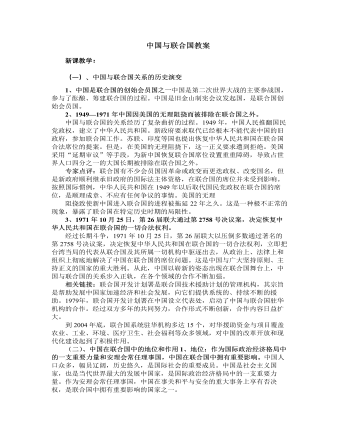
人教版高中政治选修3中国与联合国教案
(2)、中国坚持以互利合作实现共同繁荣----促进共同发展中国坚持以互利合作实现共同繁荣。中国连续担任经社理事会理事国,积极参与经社系统有关经济和社会发展的重要国际会议和其他活动并承办了联合国第四次世界妇女大会。中国积极推动南北对话和南南合作,敦促发达国家为实现全球普遍、协调、均衡发展承担更多责任。中国加人多项国际人权公约并认真履行公约义务,与联合国人权事务高级专员保持良好合作,与多国展开人权对话。相关链接:1995年9月,联合国第四次世界妇女大会在北京举行。来自197个国家和地区以及众多国际组织的1.76万名代表围绕会议主题“以行动谋求平等、发展与和平”展开热烈讨论。会议通过了《北京宣言》和《行动纲领》,为全球妇女事业的发展注入了新的活力。
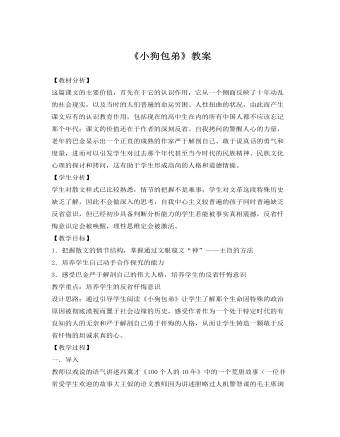
人教版高中语文《小狗包弟》教案
五.课堂总结:巴金是现代中国不多的文学大师、思想家之一,他以丰硕的文学成果以及一生坦荡无瑕圣哲般高贵的人品,向世人证明了爱心的价值、真诚的伟大,以及天才的光芒,这位“20世纪中国的良心”,他的名字必将与鲁迅等人一样,长留青史,像北斗一样在天空闪烁!让我们记住这位老人并学习这位老人的不断进取的精神和严于解剖自己灵魂的勇气,铸造一种坦诚真实的人格。六.课外合作探究:狗与“伤痕文学”巴金此文开篇就写艺术家与狗的故事,然后写自己与狗,不光此篇写狗,他在另外的文章中也写到狗,不光巴金如此,反映文革的“伤痕文学”都经常写到狗,你如何看待这一文学现象?1.学生课外阅读“伤痕文学”查阅相关文学评论(6人一组,4人分组从网上和书籍中查阅相关文章,2人分别查阅相关评论)2.课后教师与学生交流并发表有倾向性的意见:
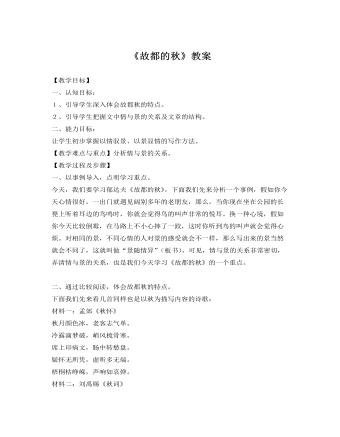
人教版高中语文《故都的秋》教案
五、分析文章结构以上分析的是3——11自然段,是本文的主体部分,下面我们来看看其他段落写什么。一问:首先我有一个问题,本文是写故都的秋,但也写到了江南之秋,主要在哪些段落?其作用是什么?明确:主要在2和13自然段,目的是以江南之秋来衬托故都的秋。二问:那么作者是抓住江南秋天什么特点来衬托故都的秋的?在结构安排上,为何要一前一后?明确:分别抓住其“看不饱,尝不透,赏玩不到十足”和“色彩不浓,回味不永”的特点,前者在第2自然段,后者在第13自然段,这样在结构上就形成了前后呼应。三问:好,从这篇文章结构来看,2和13自然段相呼应,假如1、14自然段也相呼应,那这篇文章的结构就更加严谨了,试问这两段是否有呼应?明确:第1段写作者对故都秋的感受和向往,第14段写作者对故都秋的眷恋之情,都是抒发情感,“向往”是在去故都之前,“眷恋”是在离开故都之时,其实质是一样的。所以1和14自然段也构成了呼应。

人教版高中语文《荆轲刺秦王》教案
太子丹见荆轲,一段长的谈话,包括两层意思:一是秦贪得无厌,步步紧逼;二是为此采取或生劫或刺杀的两种对策。荆轲许诺后,“恣荆轲所欲”,此时秦兵压境,荆轲未行,原来要取樊将军头作信物。文章至此,掀起又一波澜。荆轲说樊于期,首先挑起樊内心仇恨,再指出已处绝境,最后提出献首刺秦的计划。这里,荆轲沉着精细,善于体察对方情绪,了解对方心理,指出报旧仇、雪耻辱的途径。这段对话,在说明荆轲智慧特征的同时,又突出了樊于期的形象:“吾每念,常痛于骨髓”声泪俱下;“此臣日夜切齿拊心”,痛恨仇雔,愿意赴死。加上“偏袒扼腕”的描写,更加突出其来自心底的愤恨和怨怒,于是自刎,便是情节发展的必然了。已得信物,且有准备,太子的促行,与荆轲的“待吾客与俱”,形成矛盾。荆轲的缺乏助手,应是刺秦的不利因素之一。
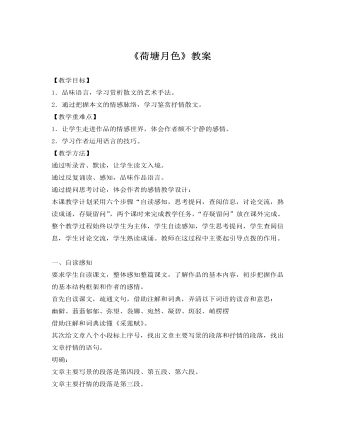
人教版高中语文《荷塘月色》教案
一、自读感知要求学生自读课文,整体感知整篇课文,了解作品的基本内容,初步把握作品的基本结构框架和作者的感情。首先自读课文,疏通文句,借助注解和词典,弄清以下词语的读音和意思:幽僻、蓊蓊郁郁、弥望、袅娜、宛然、凝碧、斑驳、峭楞楞借助注解和词典读懂《采莲赋》。其次给文章八个小段标上序号,找出文章主要写景的段落和抒情的段落,找出文章抒情的语句。明确:文章主要写景的段落是第四段、第五段、第六段。文章主要抒情的段落是第三段。文章抒情的语句主要有:第一段:这几天心里颇不宁静。第二段:没有月光的晚上,这路上阴森森的,有些怕人。今晚却很好,虽然月光也还是淡淡的。第三段:我也像超出了平常的自己,我爱热闹,……也爱冷静;爱群居,也爱独处。……便觉是一个自由的人。……我且受用这无边的荷香月色好了。第六段:但热闹是他们的,我什么也没有。第七段:这真是有趣的事,可惜我们现在早已无福消受了。
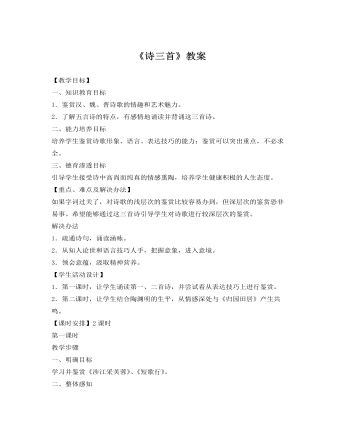
人教版高中语文《诗三首》教案
3.结合陶渊明所处的时代背景、生活经历,理解本诗的内容,体会作者的情感。陶渊明的志趣与性格、社会的黑暗污浊,终于使他同统治阶级上层社会完全决裂,回到田园中来。诗歌开篇两句写出了作者爱丘山、憎世俗的情感,统领全篇。接着以比喻、对偶的手法,生动地展示了自己为官13年的“羁鸟”“池鱼”的仕途生活,表现了对仕途的厌恶,对自由田园生活的强烈渴望。第二层作者由近及远着力描绘了田园风光:方宅以下四句,以简淡的笔墨,勾画出自己居所的朴素美好;暧暧以下四句,视线转向远处,使整个画面显出悠邈、虚淡、静穆、平和的韵味。作者正是以此作为污浊喧嚣的官场——“樊笼”——的对立面,表现自己的社会理想和人生观念,结末“复得返自然”的“自然”,既是指自然的环境,也指自然的生活。诗中诗人把统治阶级的上层社会斥为“尘网”,把投身其中看成是做“羁鸟”、“池鱼”,把退处田园说成是冲出“樊笼”重返“自然”,表现了他对丑恶社会的鄙视。在这里,淳朴、宁静的田园生活与虚伪、欺诈、互相倾轧的上层社会形成了鲜明的对比,具有格外吸引人的力量。
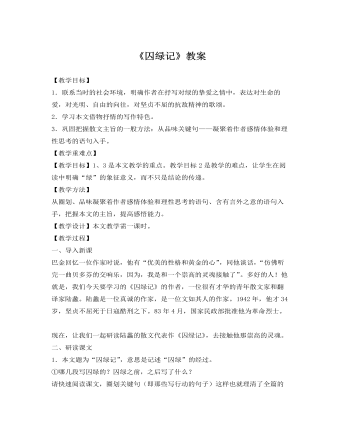
人教版高中语文《囚绿记》教案
6.小结:作者以一株常春藤为线索,牵出无限的情思,唱出了一曲绿色生命之歌。绿色是自然给予人类的审美心理需求,它给人以和平安宁的象征,给人以生命活力的感召力量。古诗词中就有不少写“绿”的名句,能背几句吗?(学生背诵,谈自己的理解。)这些诗句中写到绿,体现了诗人独特的感悟、思想,因此千古传颂。绿在视觉上给人以美感,色彩美;心理上使人愉悦,安宁。这就是一般人都喜欢绿,爱绿的原因。而我们的作者在“烽火四逼”的民族危亡时刻,不仅写爱绿,更赋予绿以时代需要的象征意义——(齐读板书。)我们从中窥见他渴望光明、自由,呼唤永不屈服于黑暗的“崇高的灵魂”。他确实有一颗——“黄金的心”。在那抗日救国的年代,《囚绿记》确有照亮民族心灵的作用。
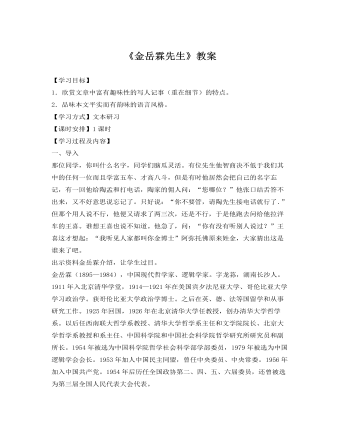
人教版高中语文《金岳霖先生》教案
一、导入那位同学,你叫什么名字,同学们脑瓜灵活。有位先生他智商决不低于我们其中的任何一位而且学富五车、才高八斗,但是有时他居然会把自己的名字忘记,有一回他给陶孟和打电话,陶家的佣人问:“您哪位?”他张口结舌答不出来,又不好意思说忘记了。只好说:“你不要管,请陶先生接电话就行了.”但那个用人说不行,他便又请求了两三次,还是不行,于是他跑去问给他拉洋车的王喜。谁想王喜也说不知道。他急了,问:“你有没有听别人说过?”王喜这才想起:“我听见人家都叫你金博士”阿弥托佛原来姓金,大家猜出这是谁来了吧。出示资料金岳霖介绍,让学生过目。金岳霖(1895—1984),中国现代哲学家、逻辑学家。字龙荪,湖南长沙人。1911年入北京清华学堂,1914—1921年在美国宾夕法尼亚大学、哥伦比亚大学学习政治学。获哥伦比亚大学政治学博士。
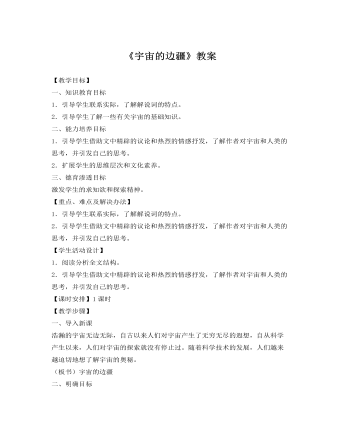
人教版高中语文《宇宙的边疆》教案
1.作者简介卡尔·萨根(CarlSagan,1934—1996),美国人,曾任美国康奈尔大学行星研究中心主任,被称为“大众天文学家”和“公众科学家”。他以对科学的热忱和个人巨大的影响力,引导几代年轻人走上探索科学之路。他对人类将无人航天器发送到太空起过重要的作用,在行星科学、生命的起源、外星智能的探索方面也有诸多成就。他主持过电视科学节目,出版了大量科普文章和书籍,其《伊甸园的飞龙》曾获得普里策奖,电视系列节目《宇宙》在全世界取得热烈反响。主要作品还有《宇宙联结》《宇宙》《布卢卡的脑》《被遗忘前辈的阴影》《暗淡蓝点》《数以十亿计的星球》等。2.解说词的文体特点课文是一部电视片的解说词,具有以下几个特点:(1)解说词要根据解说对象的特点,有明确的主题和说明重点,不能面面俱到,要突出事物的主要方面,抓住事物的关键,即使是拓展性内容,也不能游离解说的主题。如课文解说的对象是宇宙,那么就要紧扣宇宙的组成来介绍,不能随意生发其他问题。
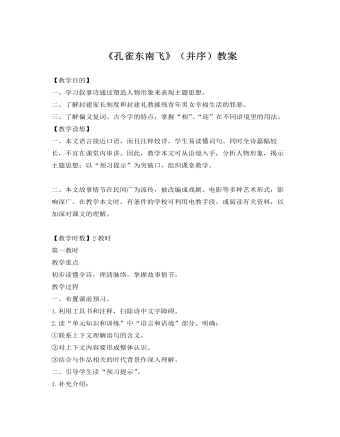
人教版高中语文《孔雀东南飞》教案
3.结合作品的时代背景,进一步理解“黄泉共为友”。故事发生在“汉末建安中”。当时的背景是:汉武帝时,“罢黜百家,独尊儒术”。儒家的那套伦理纲常逐渐占据了统治地位,并发展到了相当完备严密的程度。在婚姻制度方面就规定有“七出”、“天下无不是之父母”等等清规戒律。“天下无不是之父母”,这正是焦、刘悲剧的根本原因。在这一时代氛围里,在焦母的淫威下,焦仲卿敢于站在兰芝一边,表明与兰芝“结发同枕席,黄泉共为友”的坚决态度,实在是难能可贵的。面对儒家所规定的封建家长制度、封建礼教,焦仲卿举起的那面反抗的旗帜,无疑是茫茫长夜中的一道闪电!小结:对语境体察得越充分,对语言理解的深度和广度就越丰富。那么,我们对作品阅读理解的水平就越高。
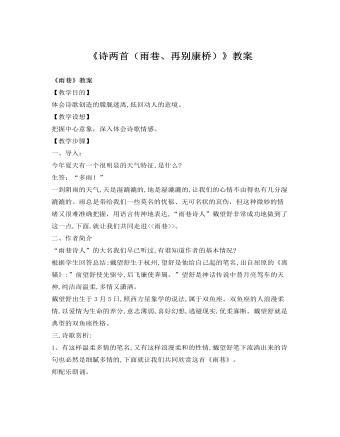
人教版高中语文《诗两首》教案
二、作者简介“雨巷诗人”的大名我们早已听过,有谁知道作者的基本情况?根据学生回答总结:戴望舒生于杭州,望舒是他给自己起的笔名,出自屈原的《离骚》:”前望舒使先驱兮,后飞廉使奔属。”望舒是神话传说中替月亮驾车的天神,纯洁而温柔,多情又潇洒。戴望舒出生于3月5日,照西方星象学的说法,属于双鱼座。双鱼座的人浪漫柔情,以爱情为生命的养分,意志薄弱,喜好幻想,逃避现实,优柔寡断。戴望舒就是典型的双鱼座性格。三,诗歌赏析:1、有这样温柔多情的笔名,又有这样浪漫柔和的性情,戴望舒笔下流淌出来的诗句也必然是细腻多情的,下面就让我们共同欣赏这首《雨巷》。师配乐朗诵。
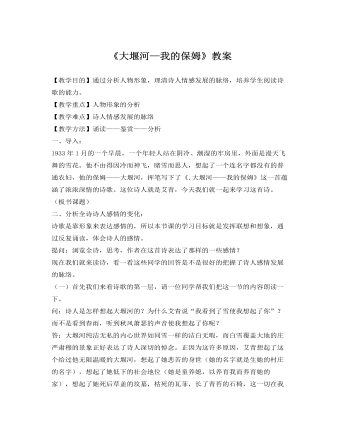
人教版高中语文《大堰河》教案
(五)是啊,谁不期望美梦成真呢?如果这个梦能实现,该有多好啊。但是,大堰河流尽自己的血汗后,就过早的离开了人世,结束了自己悲苦的一生。(教师朗读9、10节)问:大堰河死后得到的是什么?(微薄的葬礼)她生前付出的何其多,而死后得到的又何其少啊,想到这里,诗人的心一阵阵发痛,他的心中充满了对她悲苦命运的深切同情。问:是什么造成了她的悲剧?诗人对这个社会怀着怎样的感情?齐读11节,读出诗人的憎恨之情。(六)艾青的回忆到这里就结束了。在他的回忆中,我们看到了一个出身低微,地位低下,却有着金子般美好心灵的大堰河。她勤劳,善良,宽厚,她如同一座雕象,一直矗立在诗人的心中。诗人从回忆的大门走了出来,外面依然是漫天飞舞的雪花,依然是阴冷潮湿的牢房,但诗人却有着按捺不住的澎湃的激情,呈给大堰河由心灵而写成的赞歌。(教师范读12、13节)